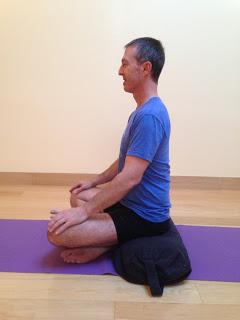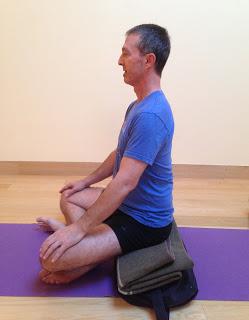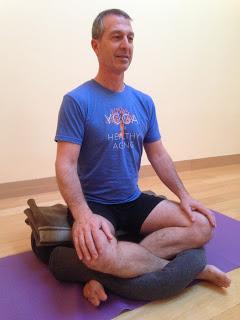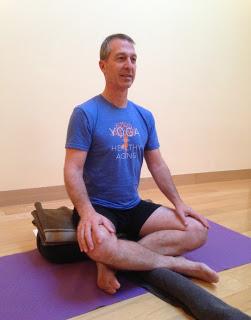Learning to sit comfortably on the floor is as important for a basic asana practice as it is for seated meditation. Yet for many people this is not an easy task!
We have addressed some of the challenges associated with this in the past, and I suggest you read Shari Ser’s post (see Learning to Sit on the Floor), with special attention to the last half of the post that covered yoga poses to strengthen the supporting muscles of the spine and back, as well as ways to improve flexibility of the spine, especially in the area of the rib cage. But I have much more to say on the subject. So today I’m going to address a question I received from one of our readers regarding sitting with crossed legs:
Something missing for me here: I can't sit cross-legged because my knees won't go down and my ankles can't stand the bend caused by knees less than halfway to the floor. I couldn't do this even when I was young, flexible, and lean. Help?
This reader highlights a reality that many of my students encounter when trying to take a comfortable seat in yoga: their bodies don’t allow them to sit easily in cross-legged position, not due to lack of work on the poses that can open and strengthen them to improve their ability to sit but instead due to something much more basic, the structure of their bodies. It turns out some people’s skeletons and connective tissue just don’t permit enough movement—particularly in the hip joint—to allow the pelvis and femur bones (thigh bones) to take the ideal positions for sitting comfortably. This usually becomes apparent after a practitioner has spent a reasonable amount of time trying to improve his or her sitting position without seeing any changes in those joints.
So today I’m going to make some suggestions for these individuals, and I suspect many of you (or your students) fall into that category! Here are my four basic recommendations:
1. Support Your Sitting Bones
First, make sure you have an adequate support under your sitting bones to elevate your hip joints for sitting. Start by placing a folded blanket or the cushion from a chair under your sitting bones and see if your hips are at or above the level of your knees. If this support isn’t enough to bring your knees to the same level as your hips, I suggest you try sitting on two to three folded blankets, on a block, or on the edge of a firm bolster. If your knees are typically very high, adding a blanket folded on top of a bolster might be necessary to bring the knees in line with hips.


 You will have to experiment with how much height you need to bring your hips high even with or higher then your knees. An additional benefit—besides making you more comfortable and allowing you to maintain the natural curve of your lower back—is that sometimes when your support is high enough, you might feel a release in your pelvis and hip joints and your knees might release a bit more than expected.
You will have to experiment with how much height you need to bring your hips high even with or higher then your knees. An additional benefit—besides making you more comfortable and allowing you to maintain the natural curve of your lower back—is that sometimes when your support is high enough, you might feel a release in your pelvis and hip joints and your knees might release a bit more than expected. 2. Support Your Knees and Ankles
I suggest that you also experiment with using some support under your knees. Using a block on each side as shown in this photo may immediately resolve any pain in you knees or hips (and maybe even your ankles).
 If you do all that and your ankles are still uncomfortable, try rolling a blanket and wrapping it around your ankles and under your knees. This alone may support and cushion your ankles and support your knees.
If you do all that and your ankles are still uncomfortable, try rolling a blanket and wrapping it around your ankles and under your knees. This alone may support and cushion your ankles and support your knees.  Another way to use the blanket for your ankles is to make a long, narrow roll and place it under your ankles where they cross, from your seated support forward. From my experience, this often brings an audible sigh of relief for those with sensitive ankles.
Another way to use the blanket for your ankles is to make a long, narrow roll and place it under your ankles where they cross, from your seated support forward. From my experience, this often brings an audible sigh of relief for those with sensitive ankles.  3. Create Your Inner Lift
3. Create Your Inner Lift As you build strength and flexibility in your spine with the poses we recommended in Shari’s post, add in an internal movement I call creating your “inner lift.” To do this, as you sit, focus on lengthening the center of your spine up from your sitting bones through the crown of your head.
Notice how long you can maintain this feeling of inner lift before you begin to sag and lose support. Then, try to re-establish the movement again for a while. If you start to tire and can no longer easily maintain your inner lift, stop for the day and note how long you sat. Try to gradually spend more time in your seated position, so that eventually you will be ready to sit for longer periods of time.
4. Rest Your Legs
If you find yourself in a situation where you need to spend a long time sitting on the floor and you realize that even in your preferred position your legs are starting to go numb or you are feeling pain, try switching to a different supported form Easy Sitting Pose to see if that helps give your legs a rest. (You can find our four variations of Easy Sitting Pose from the book Yoga for Healthy Aging: A Guide to Lifelong Well-Being at Featured Pose: Easy Sitting Pose.)
Unfortunately, even with all of these propping options, some of my students are still unable to get comfortable Easy Sitting Pose. So if that’s true for you, I recommend you try my personal favorite way to sit: Hero Pose (Virasana). Nina will be addressing how to get comfortable in Hero Pose in a future post. And if you just can’t get comfortable on the floor for extended periods, it’s perfectly okay to sit on a chair instead, especially for breath practices or meditation.
Subscribe to Yoga for Healthy Aging by Email ° Follow Yoga for Healthy Aging on Facebook and Twitter ° To order Yoga for Healthy Aging: A Guide to Lifelong Well-Being, go to Amazon, Shambhala, Indie Bound or your local bookstore.
Follow Baxter Bell, MD on YouTube, Facebook, and Instagram. For upcoming workshops and retreats see Baxter's Workshops and for info on Baxter see baxterbell.com.

